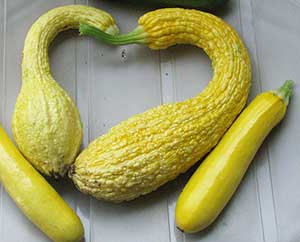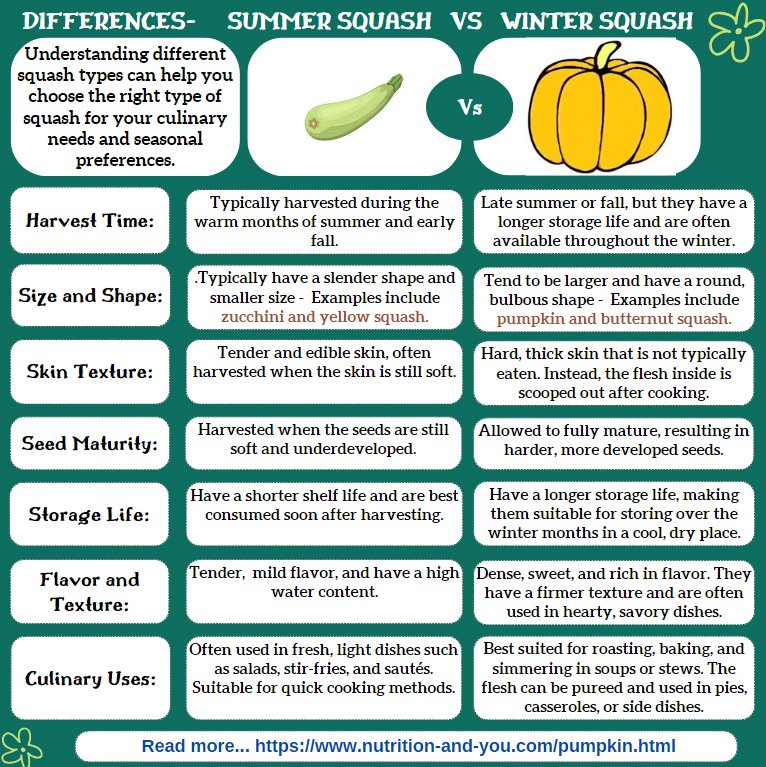Crookneck Squash nutrition facts
Crookneck squash is a type of summer squash vegetable in the gourd family and closely related to other summer squash varieties such as zucchini, pattypan squash, cocozelle, tatume, etc.
This heavily curved, elongated yellow squash is one of the popular summer squashes sought after for its sweet flavor and crunchy texture.
Scientific name: Cucurbita pepo var. torticollia.
 |
| Crookneck squash and yellow zucchini. Note for deeply bent, constricted neck. Courtesy: Bradley West |
Unlike the spreading type habitat of winter squashes, summer varieties exhibit shrub-type growth and often require a trellis to support growth. Crookneck can grow in a wide range of well-draining, fertile soils.
Golden-yellow flowers begin to appear after about 35-45 days of the seedling. Pollination occurs in the presence of honeybees. Fruits follow soon, which should be picked up while they are about 2 inches across, young, immature, and tender. Crooknecks feature constricted "swan-like" necks at the stem end and bulge towards to blossom end.
Straight neck (C. pepo var. recticollis) cultivars are a hybrid type developed by crossing between crookneck and other squash types.
Both types exhibit bright, yellow skin that is either smooth or warty and elongated, a narrower neck that gradually bulges towards the lower end. Inside, the crookneck features yellow, moisture-rich flesh with a sweet taste and crunchy texture and soft edible seeds.
If left to grow, crookneck squash soon enlarges in size, its outer peel becomes tougher, and seeds turn harder and inedible. Use protective gloves and a knife while harvesting to avoid contact with prickly stems and leaves.
Tromboncino, also known as zucchetta, is a popular cultivar in the Cucurbita moschata family. It features pale green, a very long swan-like curved neck, and a swollen, oval base. It is most often used like summer squash.
See the differences between Summer and Winter variety squashes in an infographic:
 |
10 Amazing Health Benefits of Crookneck Squash
Crookneck squash nutrition is characteristically very low in calories and fat but rich in health-benefiting anti-oxidants, vitamins, and minerals.
100 grams of raw fruit just carries 19 calories, almost the same as zucchini's (17 cal). Besides, it holds no saturated fats or cholesterol.
Its peel is a good source of vitamins, minerals, and dietary fiber. Do not discard summer squash skin.
Fresh crooknecks carry relatively smaller amounts of vitamin-A than butternuts; provide about 150 IU per 100 g. Vitamin-A is important for cell growth and development, and for good vision.
It contains good amounts of flavonoid poly-phenolic pigment antioxidants such as carotenes (90 μg-lutein, and zeaxanthin-290 μg).
Together with vitamin-A, these pigment compounds work as antioxidants in scavenging harmful oxygen-derived free radicals and reactive oxygen species (ROS) from the body.
Fresh crookneck is a very good source of vitamin-C (19.3 mg or 32% of RDA /100 g) than that in zucchinis. Vitamin C is essential for collagen synthesis in bones, cartilage, and blood vessels, and aids in the absorption of iron.
100 grams of fresh squash provides 19 µg or 5% of RDA per 100 gm of folates. Folate is one of the necessary elements involved in cell division and DNA synthesis. Adequate folates in the diet are necessary during early pregnancy to prevent neural tube defects in the newborn baby.
As in other summer squash varieties, crookneck squash nutrition also features less sodium (2 mg/100 g) but high potassium (222 mg/100 g), an important intra-cellular electrolyte. Potassium is a heart-friendly electrolyte and helps bring the reduction in blood pressure and heart rates by countering the pressing effects of sodium.
Moreover, it has good amounts of other B-complex groups of vitamins like thiamin, pantothenic acid, and riboflavin and minerals like calcium, iron, manganese, phosphorus, and zinc, and traces of selenium.
| Principle | Nutrient Value | Percent of RDA |
|---|---|---|
| Energy | 19 Kcal | 1% |
| Carbohydrates | 3.88 g | 3% |
| Protein | 1.01 g | 2% |
| Total Fat | 0.27 g | 1% |
| Cholesterol | 0 mg | 0% |
| Dietary Fiber | 1 g | 2.6% |
| Vitamins | ||
| Folates | 19 μg | 5% |
| Niacin | 0.448 mg | 3% |
| Pantothenic acid | 0.160 mg | 3% |
| Pyridoxine | 0.104 mg | 8% |
| Riboflavin | 0.041 mg | 3% |
| Thiamin | 0.051 mg | 4% |
| Vitamin-A | 150 IU | 5% |
| Vitamin-C | 19.3 mg | 32% |
| Electrolytes | ||
| Sodium | 2 mg | <0.5% |
| Potassium | 222 mg | 5% |
| Minerals | ||
| Calcium | 21 mg | 2% |
| Iron | 0.44 mg | 5.5% |
| Magnesium | 20 mg | 5% |
| Manganese | 0.172 mg | 7.5% |
| Phosphorus | 32 mg | 4.5% |
| Selenium | 0.2 µg | <1% |
| Zinc | 0.29 mg | 3% |
| Phyto-nutrients | ||
| Carotene-ß | 90 μg | -- |
| Crypto-xanthin-ß | 0 μg | -- |
| Lutein-zeaxanthin | 290 μg | -- |
Selection and storage
Summer squash, including crookneck, begins arriving in the markets from June until the end of September. In the markets, buy fresh, bright, small to medium squashes just short of maturity.
Avoid very large, hard-shelled, and over-mature squashes as they tend to be unappetizing. Also, avoid those with cuts, spots, bruises, etc.
Contrasting with other winter squashes, crooknecks do not last longer than 4-6 days. At home, store fresh squash, as you do with other summer squashes like zucchini, in a plastic bag, and place inside the vegetable compartment in the refrigerator, set at 95 degrees of relative humidity.
Preparation and serving methods
At home, wash fruits in cold water to remove any surface sand. Trim the stem end. Tender crookneck can be used with intact skin. Cut the fruit into slices, small cubes, or wedges as you may desire them in cooking.
Crookneck is used in a variety of recipes like baked, stuffed, grilled, roasted, etc.
Apart from its fruits, summer squash flowers, including crookneck blossoms, are one of the sought-after items to prepare side dishes. Male blossoms generally picked up, while female flowers left to grow into fruits. Small numbers of female flowers with intact, very tiny fruit (baby squash) are also favored as a special delicacy.
 |
| Stuffed crookneck and pattypan squash recipe. Photo: mlcastle. |
Here are some serving tips:
Crookneck squash is an inexpensive, healthy addition to meals. It can be used in substitution for another type of squash without changing the flavor of the dish.
Fresh, tender, thin sliced crookneck squash can be added to vegetable salads.
The squash blossoms dipped in chickpea flour batter, fried in oil, and enjoyed as delicious fritters!
As in pumpkin, it can be employed in soups, pies, casseroles, cakes, pudding, etc.
Baked and pureed, it can make a delicious soup.
Safety profile
Allergic reactions are rare after consumption of crookneck squash. It can be safely used in pregnant women and infants. (Medical disclaimer).
≻≻-Back to Vegetables from Crookneck Squash. Visit here for an impressive list of vegetables with complete illustrations of their nutrition facts and health benefits.
≻≻-Back to Home page.
Further reading: